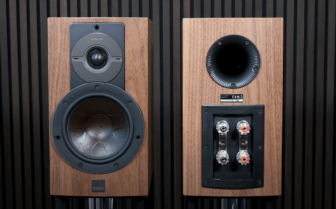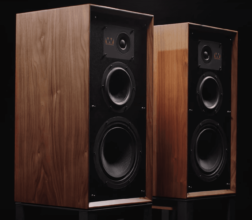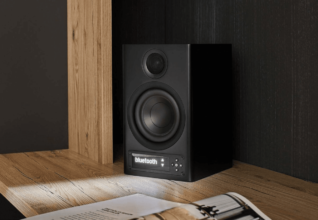Teufel Ultima 25 vs Triangle Borea BR02 Connect
Simultaneously and at the same price, Triangle and Teufel are launching new active speakers. Who wins the duel between Ultima 25 Aktiv and Borea BR02 Connect?
By Julian Holländer

Although the products tested here are similar, the rest of the portfolios of the two speaker manufacturers are quite different: Triangle mainly produces stereo speakers, while Teufel offers a broader range of products. The Berlin-based company offers everything from smart speakers and soundbars to headphones and traditional speakers.
Despite their somewhat different product lines, both companies also offer compact speakers and have just introduced models that theoretically seem very similar, especially considering their identical pair price of 550 euros.
Triangle has introduced the BR02 Connect, the active version of its entry-level Borea series, incorporating some technologies from its more expensive series into this new model. Teufel’s contender is called Ultima 25 Aktiv; these speakers are also the active version of a series aimed more at beginners.
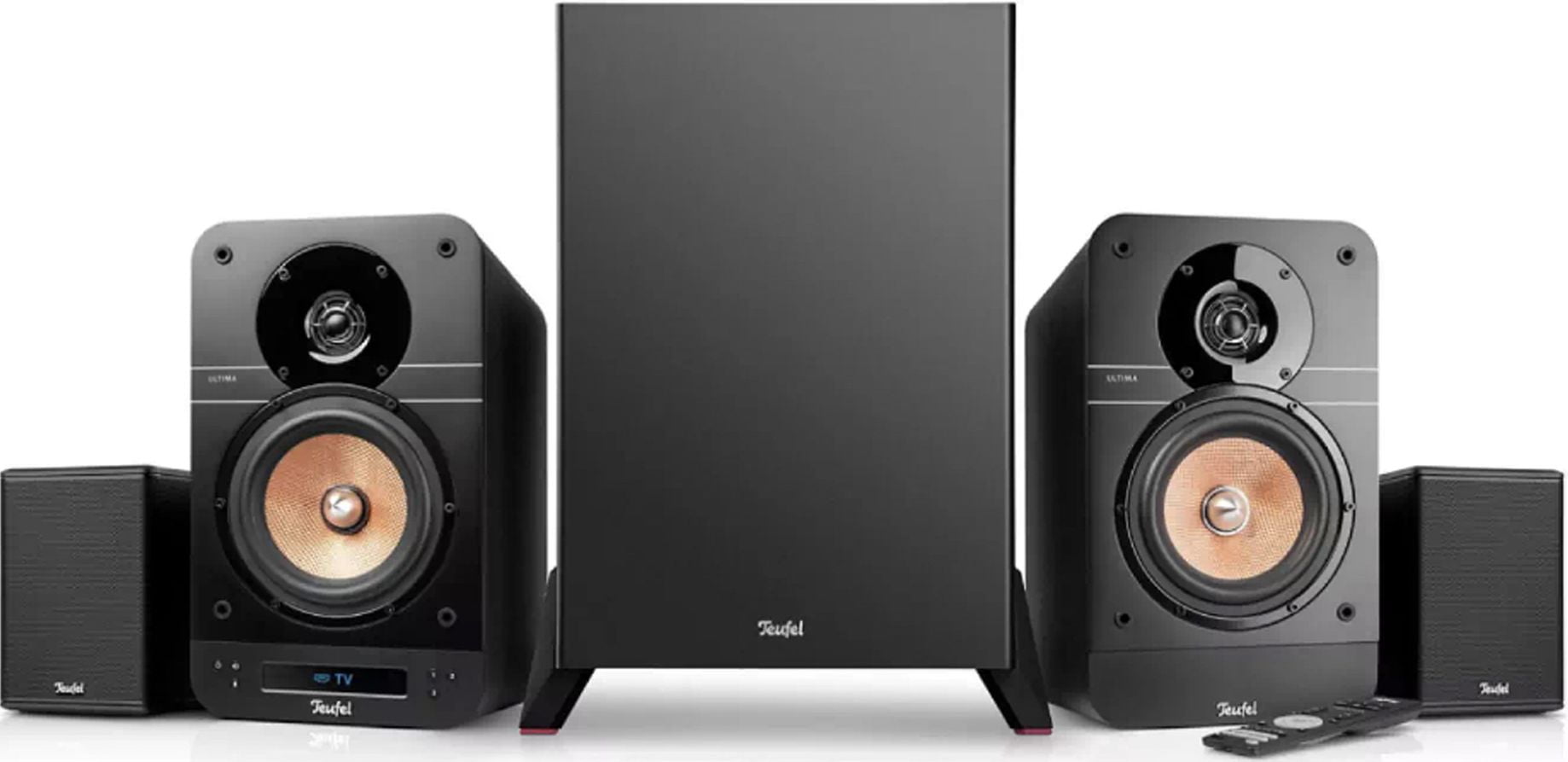
Both devices follow the same concept: they are active speakers, meaning they handle both amplification and sound conversion, as well as digital-to-analog conversion, all within the same housing. A significant advantage of this concept is the space-saving benefit. Additionally, manufacturers can optimize all components to work together seamlessly.

Phono to High-Res and Radio
To listen to music, of course, sources are needed, and the speakers should offer as many different inputs as possible.
Both test candidates come with an analog RCA input and an optical digital input. This already covers a wide range of possible music sources. Both also have USB and HDMI-ARC inputs, allowing them to be connected to a computer or TV. Teufel features the more modern USB-C standard, while Triangle uses USB-B.
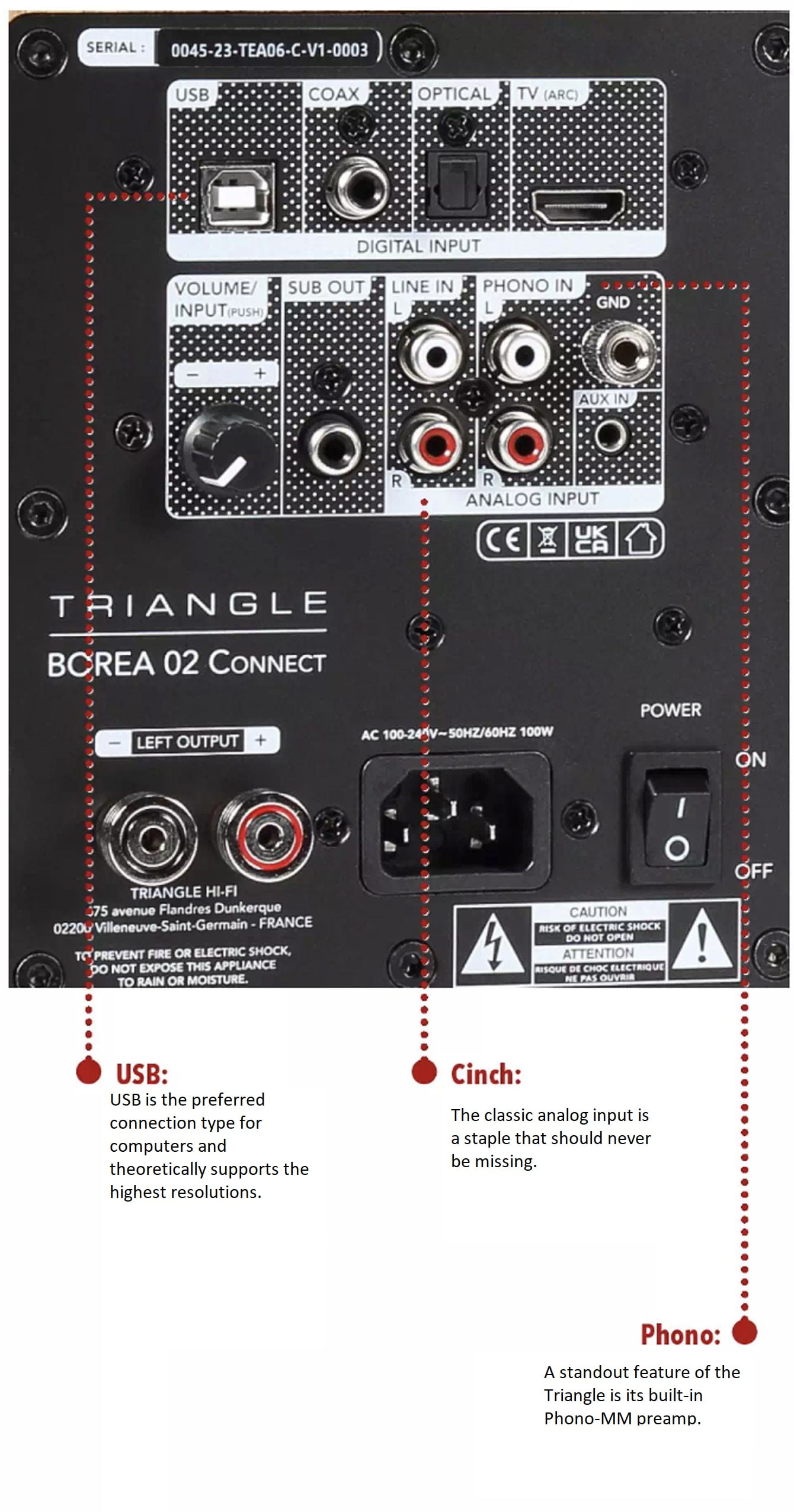
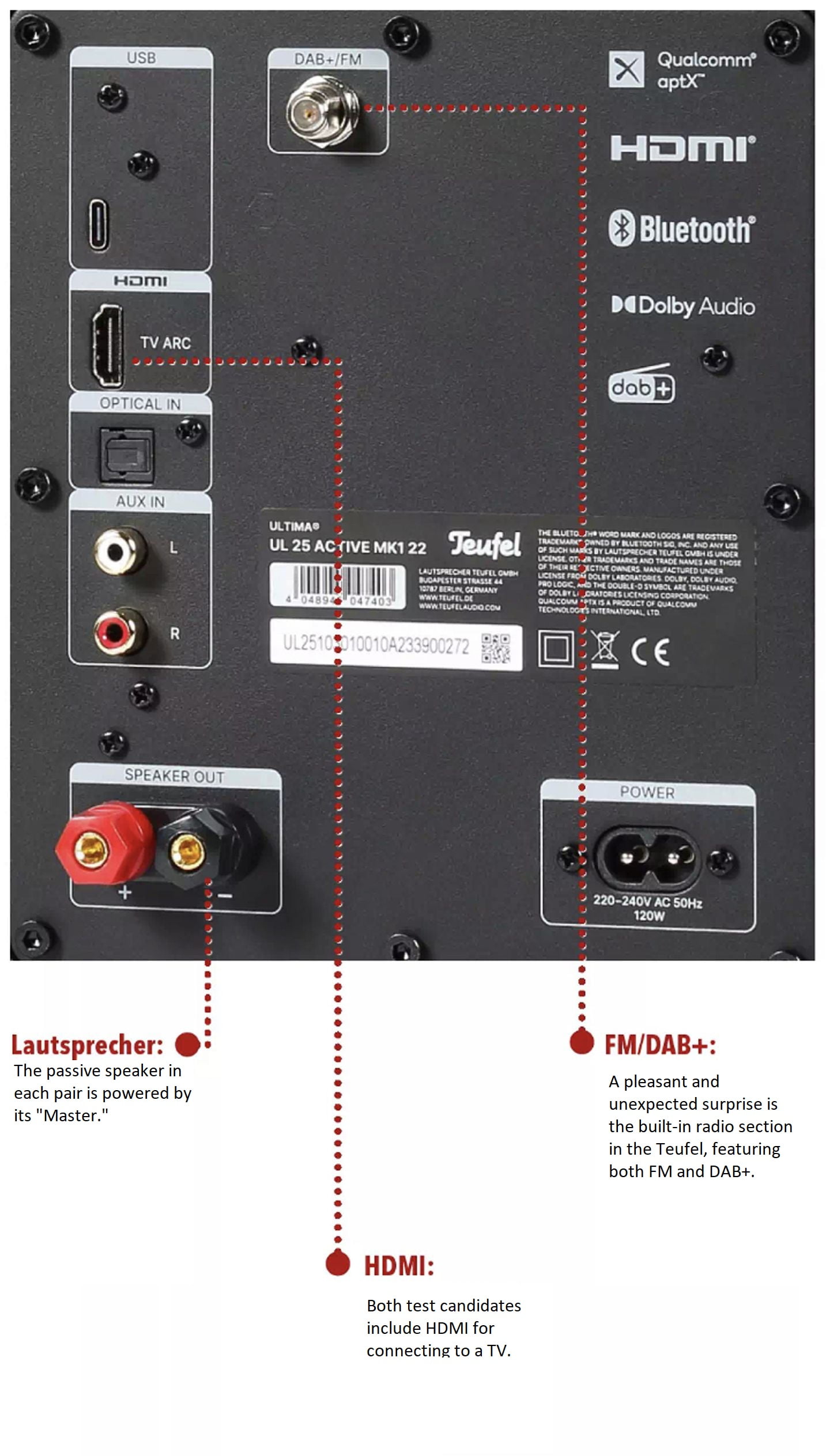
Teufel’s offering ends there, but Triangle offers an almost perfectly complete package in terms of connectivity. In addition to the aforementioned connections, it also includes a 3.5mm jack and a coaxial digital input. For active speakers in this price range, the phono-MM input on the Triangle is somewhat unexpected but very welcome, as it allows the connection of turntables without a built-in phono preamp.
While on the subject of technical features, the aspect of high-resolution music is also worth mentioning: the Borea BR02 Connect supports resolutions up to an impressive 24-bit/192 kHz via optical and coaxial inputs, and even up to 32-bit/384 kHz and DSD256 via USB. Teufel also quotes 24-bit and Dolby Digital for TVs. Both candidates can wirelessly receive music in “CD-like” quality thanks to Bluetooth with aptX (or aptX HD in the Triangle).
Looking back at the Ultima 25, there’s another feature that we’ve never really seen in this type of device: a fully functional radio module with DAB+ and FM tuner, as well as station memory. This means that not only does the Teufel have an additional connection, but it also has a built-in source. Thanks to the included, albeit somewhat short, antenna cable, nothing else is needed for radio listening.
Triangle also includes a subwoofer output for expansion; the Ultima can connect wirelessly with a Teufel subwoofer, but only with Teufel models, not those from other brands. Triangle, on the other hand, supports this, though not wirelessly.
The Speaker Concepts
With this variety of connections, both speaker manufacturers aim to offer affordable all-rounders that can perform in all conceivable scenarios, from near-field desk use to home theater replacement, and of course, focused stereo listening. Besides versatility and price similarity, both models are conceptually similar: they are “Master/Slave” active speakers, where a main speaker houses all the electronics and sends signals to the “Slave.” On paper, the amplifier in the “Master” provides equal power output of 50 watts per channel in both models.
Both boxes are also active versions of affordable passive speakers – both the Teufel Ultima 25 and Triangle Borea BR02 cost around 350 euros (RRP) without an amplifier. This suggests that the passive and active parts of both systems likely cost the same.
Equipped with the same technology, but offering more power and a larger woofer, Triangle also offers the BR03 Connect for 100 euros more. This is the active version of the Borea BR03, which impressed as part of an affordable system. The activation of the Borea likely brought other changes besides the addition of the amplifier: in the BR03, the bass reflex ports moved from the front to the back, which required some design adjustments. In comparison, Teufel’s Ultima active series also includes a full-fledged floor-standing speaker, the “40.”
Despite all the similarities, there are naturally differences as well; as mentioned earlier, Teufel offers a radio, while Triangle leads in terms of the number of connections. Another point of difference is the control options.
Control and Operation
Aside from a small rotary knob for volume and input selection on the back, the Triangle only responds to the remote control. Its competitor, on the other hand, comes with a screen, buttons, and a volume slider on the Master box. These do not cover the full functionality of the remote, but in addition to input selection and volume control, they provide direct access to presets, play/pause, and mute, as well as full control over the radio tuner. This is a significant advantage if the speakers are being used as desktop speakers connected to a computer via USB, allowing for adjustments directly on the device without having to reach for the remote. Even from a distance, the screen allows for very good navigation through the options.
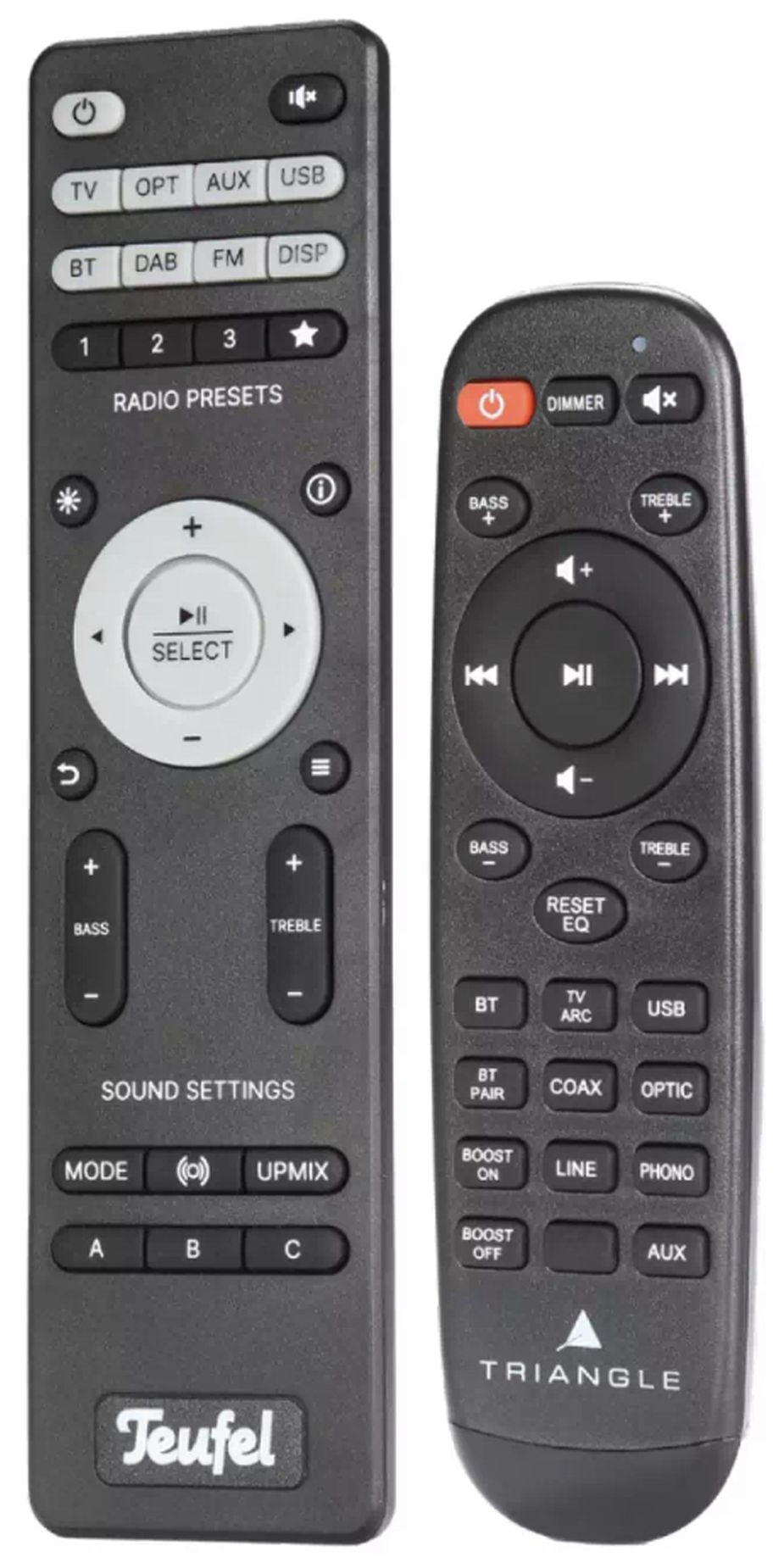
Another difference is the size of the two speakers: the Ultima is a few centimeters larger in height and width. This provides space for a larger woofer, but depending on personal taste, the Teufel speaker may already be a bit too large for an average desk, where the more space-saving Borea might fit better.
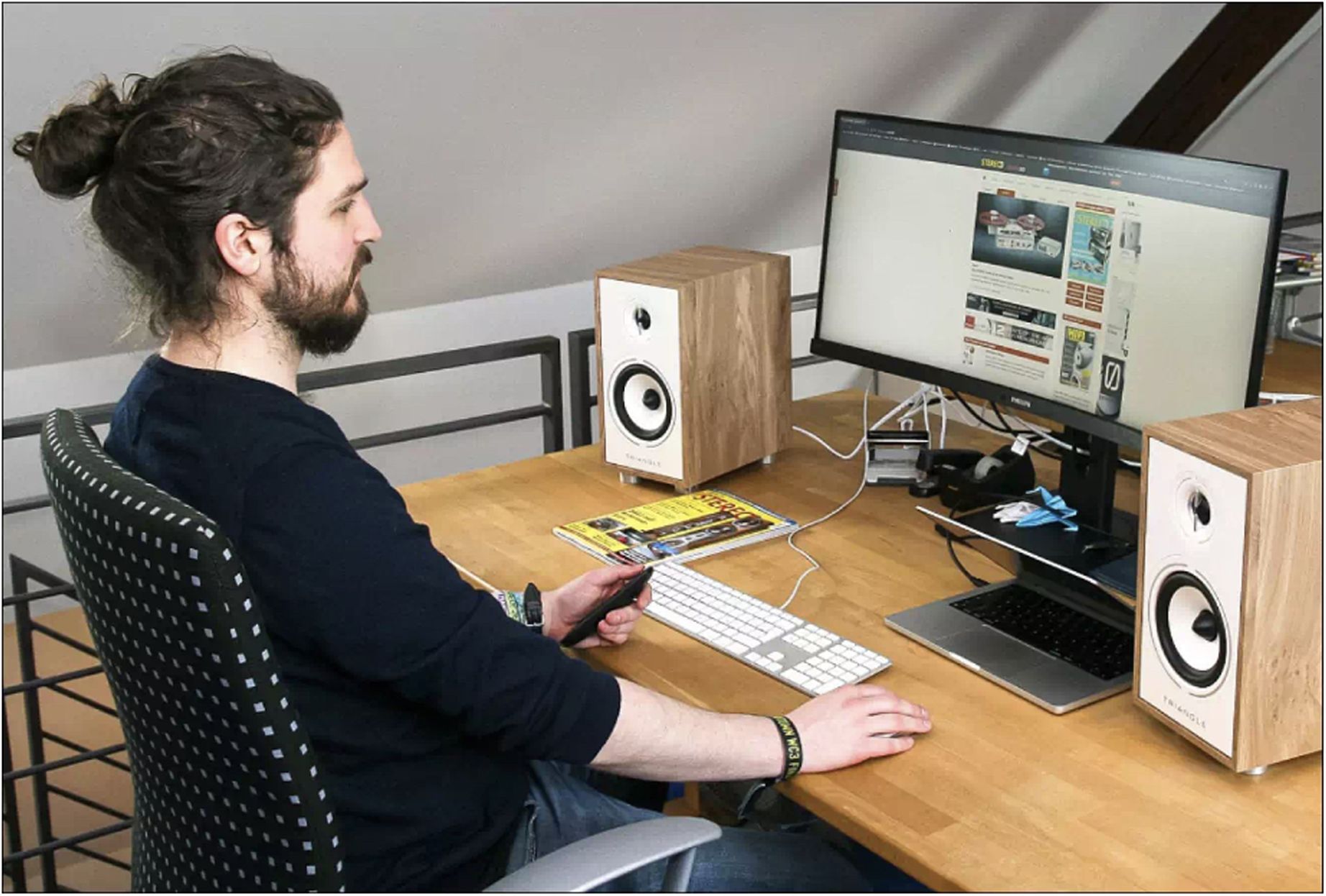
No matter where they are placed, the speakers must always be positioned correctly, and the position of the “Master” in the Teufel set can be freely chosen (left/right). In contrast, the active Triangle speaker must be on the right side, and the passive counterpart on the left. This shouldn’t be a major obstacle but could make placement slightly more complicated, as the Master requires a power cable and serves as the interface to the sources.
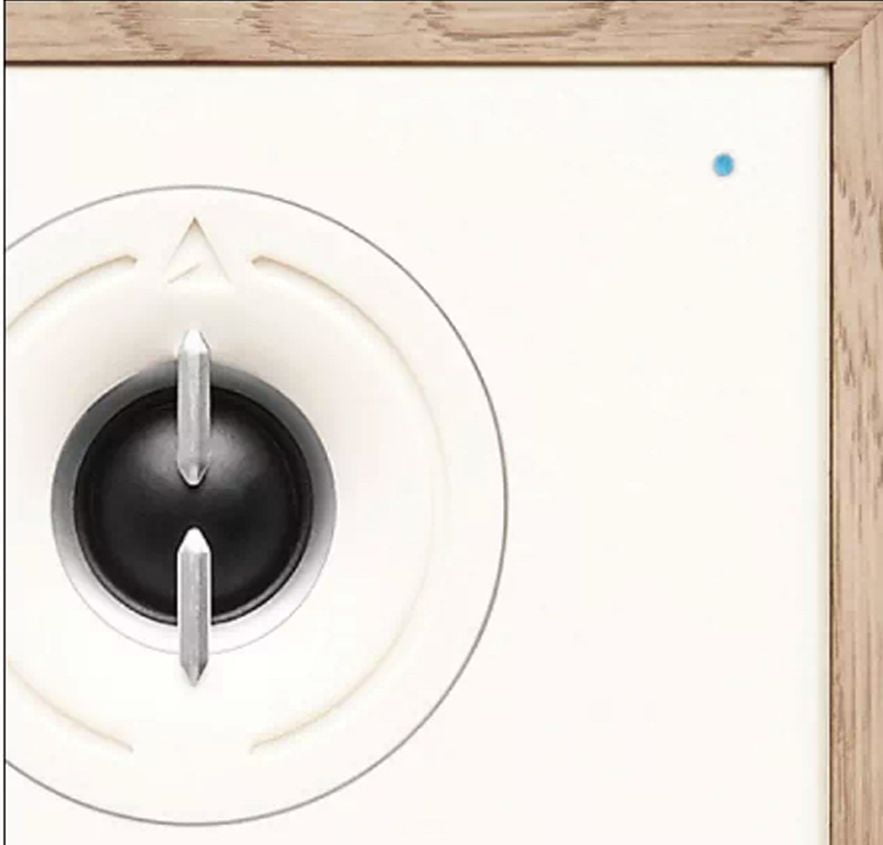
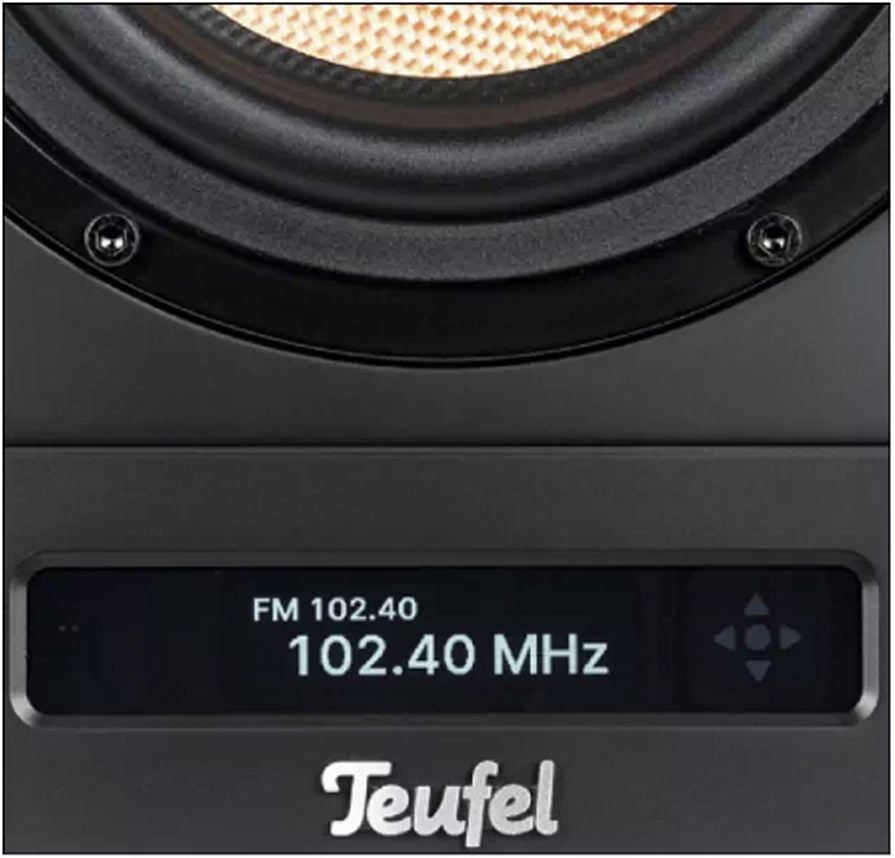

Sound Improvement?
When discussing the beginner-friendly price of 550 euros, the competition must also be mentioned. This segment is bursting with device categories that could be considered somewhat comparable: there are plenty of complete systems, smart speakers, or soundbars in the 500 to 600 euro range. Without built-in network streaming, for example, the active speakers tested here fall slightly behind such devices in terms of features – but they aim to make up for this with their high sound quality. One thing Ultima 25 and BR02 Connect have in common with these devices is the frequently available option for sound adjustment.
Both offer an equalizer that allows the enhancement or reduction of highs and lows. The Triangle also has a “Bass Boost” that balances the bass range, especially at low volumes – and it does so effectively. For songs with a lot of bass at high volumes, it can almost be too much, although it can provide a quick wow effect. When the volume is lower, or the music has little bass, the speakers gain a nice extra amount of bass volume, giving the overall sound more fullness and punch.
Teufel, on the other hand, offers the options “Music,” “Movies,” “Speech,” and the attenuating “Night” mode, as well as its proprietary “Dynamore” system. We already encountered both in the review of the Cinebar 11 soundbar, and our conclusion is similar: the movie mode is designed for TV and is recommended for that purpose, but for music and the naturalness of voices, we recommend as neutral settings as possible. This would be “Music,” which, according to Teufel, has a “slight emphasis on bass and treble.”
ACTIVE SPEAKERS: THE CONCEPTS
Active speakers are speakers with at least part of the amplifier built in and part of the set. An overview of the most common concepts:
Most active speaker concepts can be grouped in various ways, such as by the internal technology:
- Speakers with built-in amplifiers, often used as monitor speakers, are the origin of active speakers. These have nothing but the amplifier built in, while sources, as well as preamplifiers – and thus volume control – are external.
- Models with the entire amplifier, i.e., both preamplifier and power amplifier, built in and directly connected to music sources form the next group. This includes the Teufel and Triangle from this test. In addition to analog inputs, both have digital inputs – USB, HDMI, optical, Bluetooth, etc. – and thus also function as D/A converters.
- Active speakers with streaming can be considered a third group. These also have built-in amplifiers and D/A converters, as well as a streaming section, requiring an internet connection. Since they come with a built-in music source, they can completely replace a system from front to back. They often offer “smart” features like room correction and are sometimes referred to as “smart speakers.” However, they should not be confused with smart speakers in the sense of often voice-controlled all-in-ones.

Active speakers can also be classified by where the technology is located:
- The “Master/Slave” concept is common, and both models tested here work this way. All the electronics, including the connections, are in the active “Master,” which has a speaker output that feeds the passive “Slave.”
- Both boxes can be active, meaning both require power and have their own amplifier. Such setups are often more complex and can sometimes communicate with each other wirelessly. This category includes both active and fully active speakers.
- Fully active speakers are the most complex option and offer the highest potential in terms of sound quality. They have an active crossover instead of a passive one, meaning the amplifier drives the drivers directly, which can only be achieved in pure active speakers.
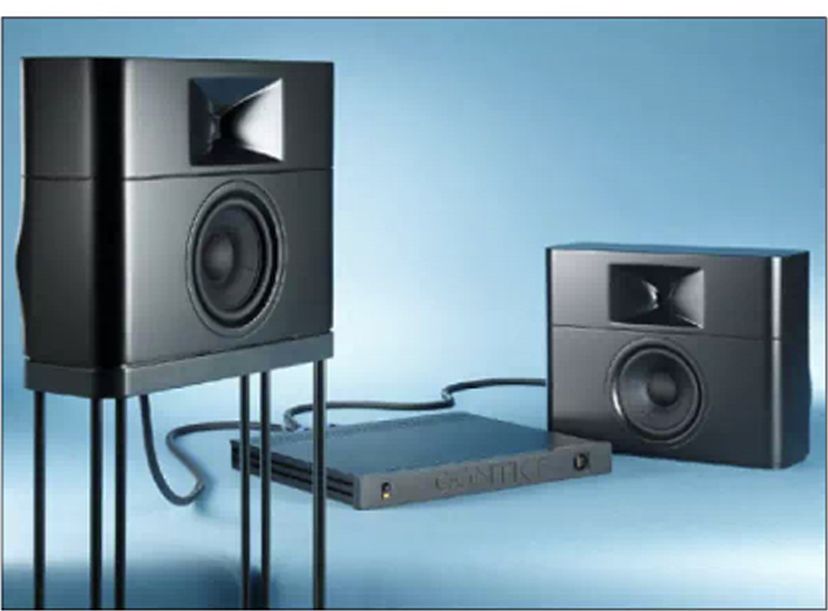
The crossover in the passive speaker connects the amplifier to the drivers. It’s necessary because the amplifier amplifies all frequencies, while individual drivers are only responsible for specific frequencies. Therefore, a tweeter must be connected to the high-pass filter and a woofer to the low-pass filter.
The crossover in fully active speakers comes before the amplifier and splits the music signal into treble and bass signals. Then, the power amplifier amplifies the signals separately, allowing the crossover to work very accurately. Furthermore, a treble amplifier only has to deal with the relatively low energy requirements of high-frequency signals, while a bass amplifier can work in a more relaxed range. The greater the differences between the frequencies, the higher the quality of this concept.
Which One Sounds Better?
To evaluate the sound quality, we used a wide range of listening tests with different types of music, directly comparing both speaker pairs.
For a general overview, we started with two radio hits that had great success on German airwaves, and which almost everyone knows: Coldplay’s “Clocks” and Michael Jackson’s “Billie Jean.” After activating both systems and listening to them for a few seconds, the answer seemed clear: the Triangle wins. But then we listened to other tracks like “Viva La Vida,” which sounded slightly better with the Teufel, with its more open sound image and a bit more warmth.
The soundstage of the Berlin speakers isn’t perfect either, but Coldplay’s hit often sounds slightly tinny on many systems, including the Triangle. To be fair, the Teufel also made certain sections of the track sound thin. In general, the Teufel has a slight warmth and is a bit more restrained, but overall, it delivers a very balanced sound.
The Triangle system, on the other hand, is much more lively and fresher, especially in the midrange, as well as slightly more detailed. This is clearly noticeable, for example, in “Billie Jean” and the singing. Michael Jackson’s voice sounds more direct and clearer in the Triangle. The “boom-boom” bass in the background is emphasized much more than in the Teufel, and the beat almost compels movement.
Switching to a calmer piece, Pink Floyd’s “Comfortably Numb,” the result remains consistent. Here, too, the Triangle impresses with more intense reproduction of individual elements like the bass and the lively background vocals.
In contrast, the Teufel is less offensive but still able to keep up. David Gilmour’s voice sounds more relaxed and is less prominent, but the track is also rendered more neutrally overall. The stereo image remains very good, and the guitar solo at the end doesn’t overwhelm the listener as much as with the Triangle. However, the less vivid character could also appeal to some listeners, as it provides a more rounded presentation.
The differences between the two speakers only become more pronounced when moving into more complex pieces. That’s when the Triangle’s liveliness really comes into play and outshines its competitor. However, there were also tracks like Alan Parsons Project’s “Sirius,” where the Teufel was more in its element and delivered the slightly more pleasant sound.
Ultimately, the result is very close and depends heavily on the type of music being listened to and personal taste. Both speakers are excellent for their price and have a lot of power. The Teufel’s strengths lie more in balanced and relaxed reproduction, while the Triangle excels in lively and detailed sound. Each system, therefore, has its own merits.
In conclusion, while both speakers are very capable, the Triangle’s Borea BR02 Connect might be the better choice for those who value detailed and lively sound reproduction, while the Teufel’s Ultima 25 Aktiv could be better for those who prefer a more balanced and relaxed listening experience. However, both speakers offer an impressive performance for their price range and are solid choices depending on individual preferences.
The Test Result
– Triangle Borea BR02 Connect: Versatile speakers with excellent connectivity options, a lively and detailed sound that excels in midrange reproduction, making them a great choice for those who enjoy a vibrant listening experience.
– Teufel Ultima 25 Aktiv: Balanced and warm sound with a focus on relaxed listening, suitable for those who prefer a more neutral and calm sound presentation.
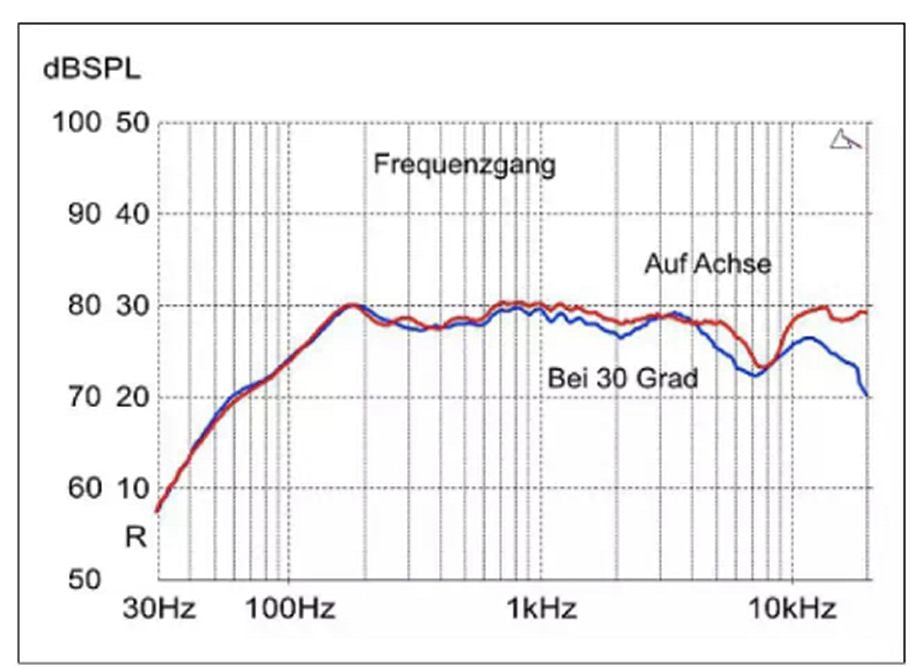
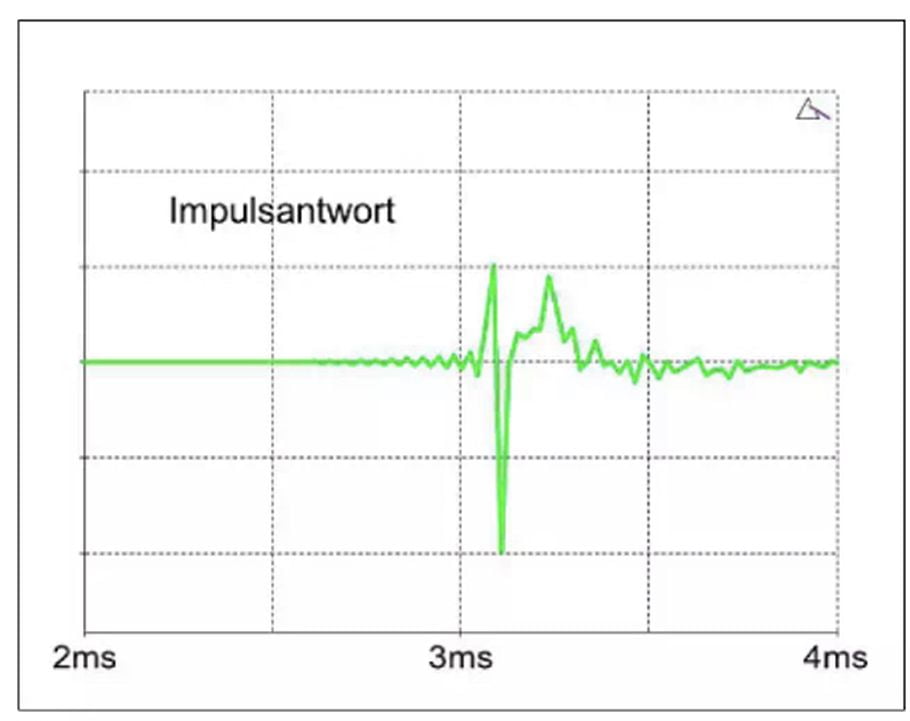


| Feature | TRIANGLE BOREA BR02 CONNECT | TEUFEL ULTIMA 25 AKTIV |
| Product Type / Price Range | Bookshelf Speaker Active / up to €1,000 | Bookshelf Speaker Active / up to €1,000 |
| Website | www.trianglehifi.com | www.teufel.de |
| Price in Euros | 549 | 549 |
| Dimensions (WxHxD) in cm | 17.6 x 31 x 27.4 | 21.5 x 36.5 x 25 |
| Weight in kg | 11.2 | 14.5 |
| Principle | 2-way, bass reflex | 2-way, bass reflex |
| Communication Between Speakers | Master/Slave, wired | Master/Slave, wired |
| Recommended Placement | On stands, slightly angled inward | On stands, slightly angled inward |
| Sound Quality (Rating) | 45%, good (1.8) | 45%, good (2.1) |
| Sound Quality Description | Very good definition and clarity, slightly weak bass but well-rounded | Powerful but balanced, slightly less detailed |
| Measurement Results (Rating) | 10%, good (2.3) | 10%, adequate (3.7) |
| Frequency Response | Balanced | Unbalanced |
| Impulse Response | Good | Somewhat poor |
| Distortion at 63 kHz / 3 kHz / 1 kHz | 0.79 / 0.08 / 0.28 | Not measurable / 0.17 / 0.13 |
| Features (Rating) | 15%, good (1.9) | 15%, good (2.3) |
| Sound Adjustment Possible | Yes | Yes |
| Finish Options | Blue Oak, Oak, Oak Green, Cream, Light Oak, Black | Black, White |
| Included Accessories | Grill, Absorber | Grill, Absorber |
| Build Quality | Good | Satisfactory |
| Connections | RCA, Phono-MM, HDMI, Optical, Coaxial, USB-B, Sub Out, 3.5 mm jack | RCA, HDMI, Optical, USB-C |
| Bluetooth | Yes | Yes |
| Expandability | Subwoofer (wired) | Subwoofer (wireless), Rear Speaker |
| Usability (Rating) | 20%, satisfactory (3.3) | 20%, good (2.1) |
| Placement | Very easy | Easy |
| Initial Setup | Easy | Very easy |
| Remote Control Quality | Functions good, build quality satisfactory | Functions good, build quality satisfactory |
| On-Device Controls | Complicated | Easy |
| Display | No display | Good display |
| Manual Quality | Only English / French | Good |
| Service & Environment (Rating) | 10%, satisfactory (2.7) | 10%, satisfactory (2.7) |
| Warranty in Years | 2 | 2 |
| Packaging | Cardboard and Styrofoam, speakers in plastic | Cardboard and Styrofoam, speakers in plastic and fabric |
| Test Result | Good (2.2) | Good (2.3) |




